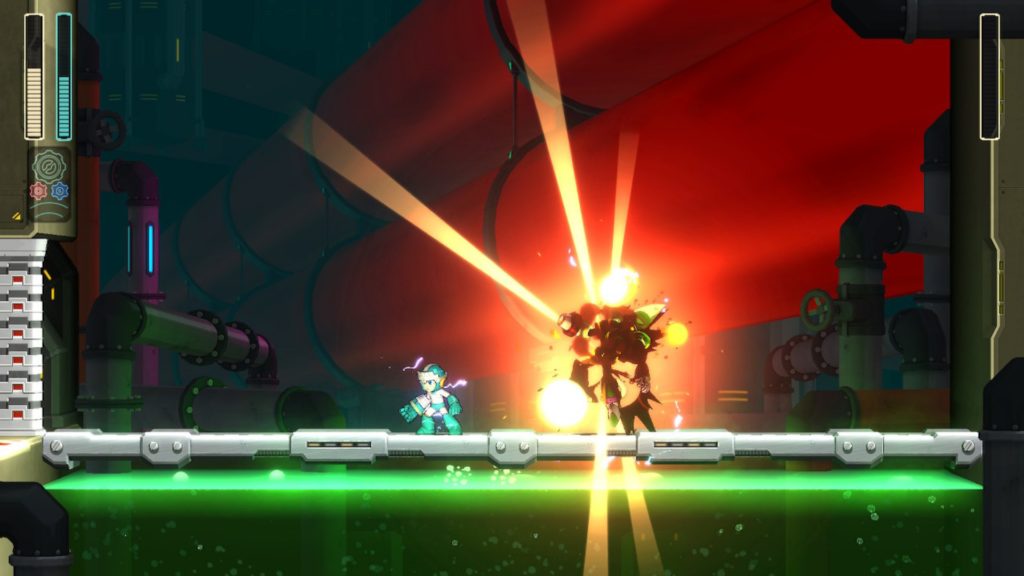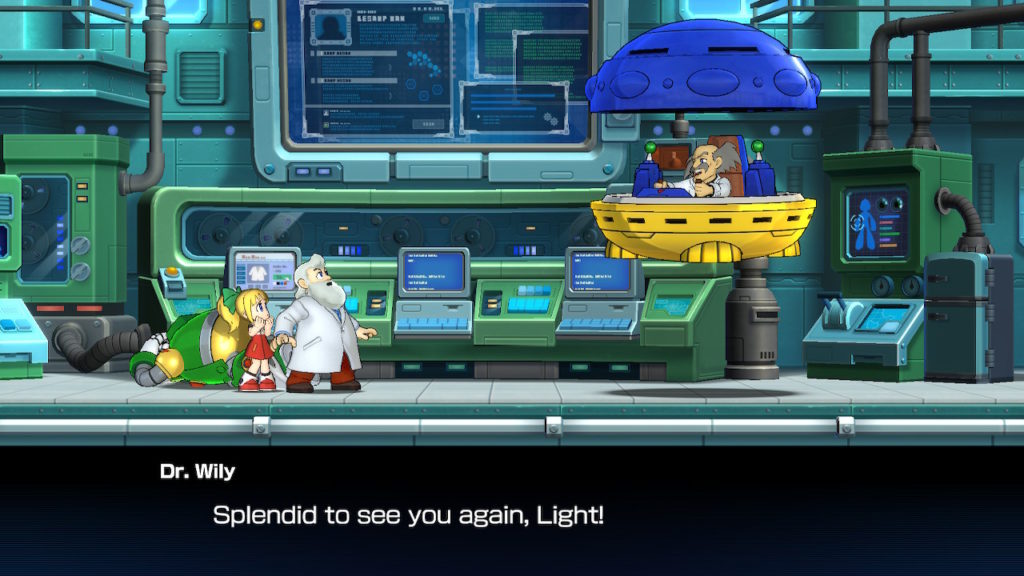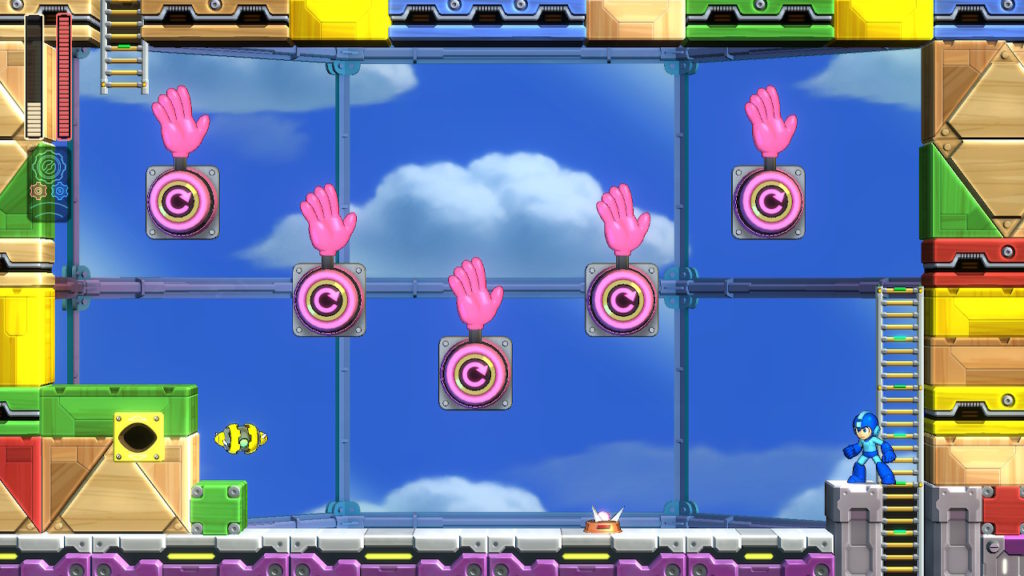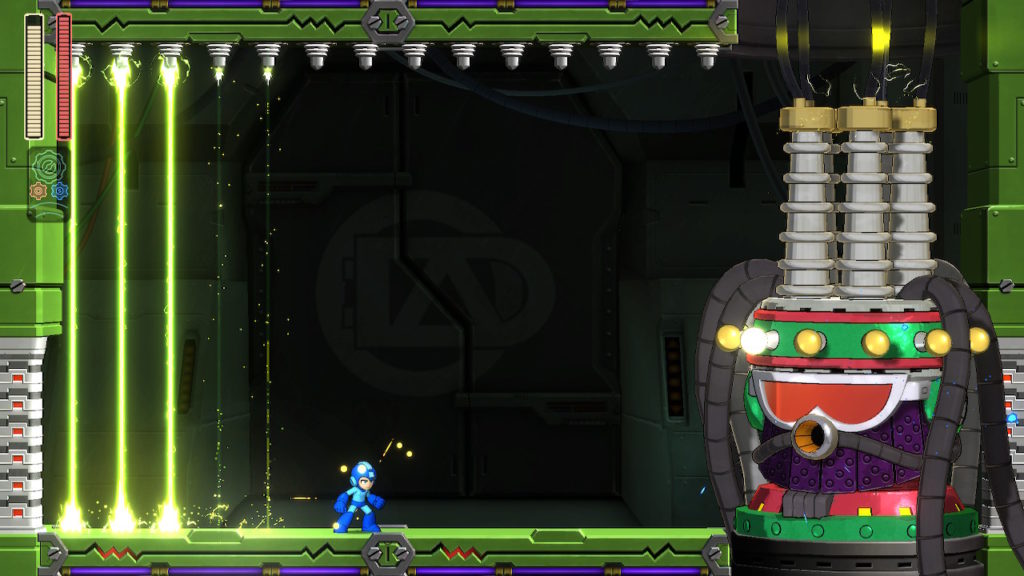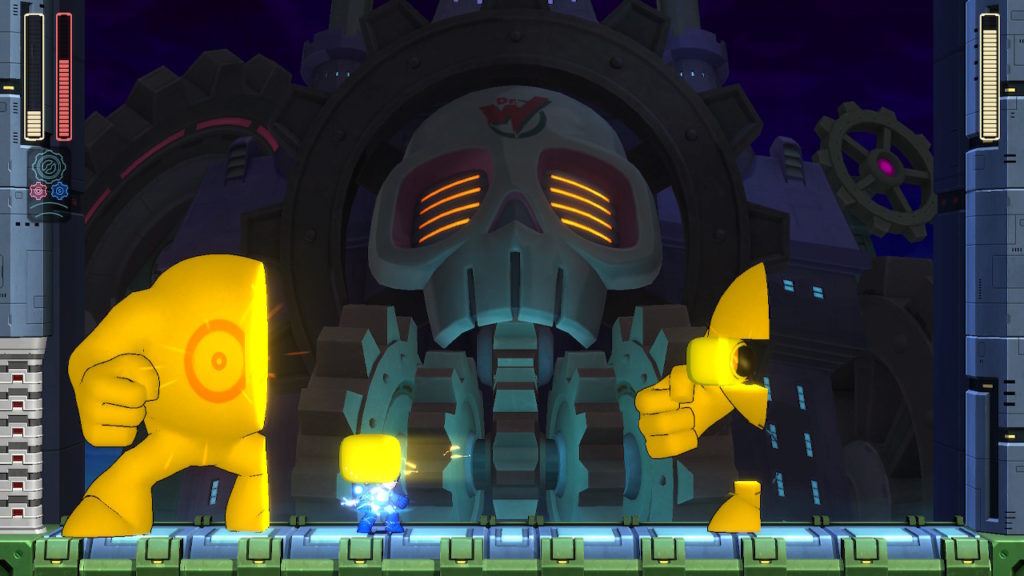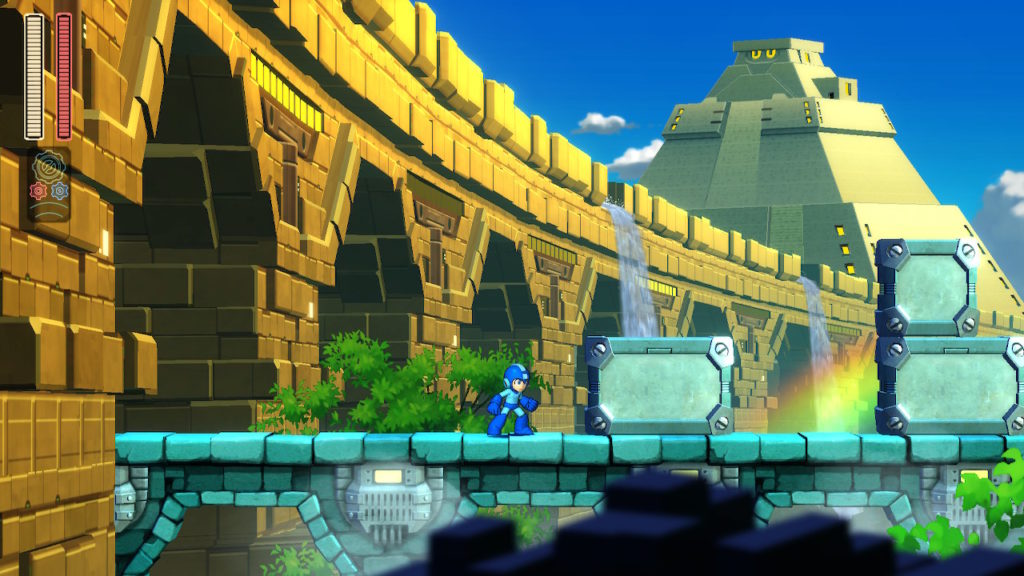- TITLE: Mega Man 11
- DEVELOPER: Capcom
- PUBLISHER: Capcom
- PLATFORMS: PlayStation 4, XBOX One, Switch, & PC
- GENRE: Action Platformer
- RELEASE DATE: October 2, 2018
- PRICE: $29.99 USD
Fans of Capcom’s long-running franchise of action-platformers are likely used to long waits between games by now. Sure, back in the blue bomber’s heyday Capcom was pumping out games left and right. Between 1987 and 1998 the series saw nine major entries on home consoles, several side-stories on the Game Boy, and even some quirky experiments like Mega Man Soccer, Mega Man Battle & Chase, Super Adventure Rockman, and a couple arcade entries. And this list doesn’t even include titles from the Mega Man X series or the 3D adventure Mega Man Legends. However, after 1998’s Rockman & Forte (later ported as Mega Man & Bass), fans would have to wait a decade for the release of Mega Man 9. Then, in 2010, we got Mega Man 10. After that, a lot more waiting…Until now!
However, Capcom went through a lot in the years since Mega Man 10‘s release and although they knew there was a strong interest from fans to see a new entry in the classic series, they decided not to rush another game out the door, opting instead to wait until someone had a very original idea to pitch. Was it worth the wait? Let’s dig in and see for ourselves!
In my opinion, Mega Man 11 is a very welcome modern addition to the franchise. While I appreciate the nostalgia that Capcom was playing to when it released Mega Man 9 in the 8-bit style of the NES classics, I wanted to see them do something different with Mega Man 10. Sadly, while it was still a fun game, it was ultimately disappointing in a few regards. I think it was a good idea for the company to go back to the drawing board and ponder what they could do differently the next time around, because Mega Man 11 feels like a breath of fresh air for the series. Sure, the basic formula remains the same (defeat 8 original Robot Masters, gain their powers, and take on Dr. Wily’s latest fortress) but the way the game handles things feels new and exciting.
This time around, Capcom gives us a more intimate look into the history between famous robot-designers Dr. Light and Dr. Wily, particularly an event in their younger days that led to their falling out and subsequent rivalry. As it turns out, the two scientists both shared a dream of a world where robots would be free and independent, able to serve as heroes to humankind and themselves. While Dr. Light believed in working towards research into self-awareness, Dr. Wily believed that pushing the boundaries of what they were capable of would make them stronger and able to stand apart from being simple tools for humans to take advantage of. Dr. Light, however, believed this technology was dangerous and pushed for the committee to back his research over Dr. Wily’s. The end result was the destruction of their friendship and Dr. Wily’s drive to prove Light wrong and set himself up as the greatest genius of all time.
Now, in the game’s present-day, Dr. Wily looks back on his abandoned “Double Gear System” and decides to implement it into a new batch of robots in a new effort to take over the world. Mega Man, always one to fight for justice, asks Dr. Light to install the system in him so that he can stand a chance at putting an end to Dr. Wily’s latest efforts.
The “Double Gear System” ends up providing a new, fun twist on the classic gameplay style. As the name implies, this technology gives Mega Man two distinct abilities: the ability to move so quickly that time appears to slow down and the ability to overclock his Mega Buster and enemy powers. Because Mega Man now has these cool new abilities, certain aspects of the game have been designed around their use. Certain enemies, for example, seem to move more quickly than normal, making the use of the time-slowing gear very useful in taking them down. Some areas that require fast, precision jumping are also aided by the ability to slow the game down and line your movements up just right. The ability to push your powers to new levels also can make taking down certain enemies and bosses a bit easier too. Yet, over using the gears will cause Mega Man’s systems to overheat, making the gears unusable and weakening the power of his primary weapon until his system cools down a bit, so you’ll want to be careful not to push him too hard in critical situations.
I think Capcom made a good decision though in designing the game in such a way that using the gears never feels completely necessary for success. Sure, making use of the right gear in the right situation makes very difficult sections of the game much more bearable, but I never felt that the game was forcing me to use them in order to succeed. This is even true of boss fights, which are certainly aided by the use of the gears (particularly the ability to slow things down a bit) but are also certainly winnable without them.
Of course, the various Robot Masters and later bosses of the game can also make use of these gears in new and interesting ways, adding a bit of depth to their boss fights. When a boss speeds itself up, Mega Man can counter with his own speed gear, bringing the fight back to an equal playing field.
One thing I really liked about Mega Man 11 is its interesting cast of Robot Masters. Capcom did a great job of providing them with a stronger sense of character, giving them a good deal more depth and personality than they have before. Each of the Robot Masters feels unique in their own way and has some great one-liners during their battles that often gave me a good laugh. Their fights are a lot less cookie-cutter than in previous games, too. Each boss has several different attacks that they can use rather than simply relying on the constant spamming of their primary weapon, and when their health drops to around its halfway point during a fight, they tend to make use of one of their gears in order to unleash some very powerful and devastating attacks. They can certainly be defeated with the basic Mega Buster if you wish, but they each have a weakness that can generally make fairly quick work of them. And that brings me to another topic: the Robot Master weapons. Each of the weapons in Mega Man 11 feels useful and not like something you’d discard after using it to take down one of the bosses. Generally, yes, I tend to play using the Mega Buster throughout most of the levels and almost forget I have a pretty great arsenal at my disposal, but the weapons here can really help you out of some tough spots, particularly in Dr. Wily’s Gear Fortress.
Graphically, I really like what Capcom did with this game. They did a fantastic job of maintaining the classical 2D platforming look and style while making the environments very detailed and fresh. Although you are often in a rush to dodge enemy attacks, make some difficult jumps, and avoid dangerous obstacles, it’s a good idea to take a moment to stop and look around when you can because each of the levels are filled with little details that will often give you a smile. Torch Man’s level, for example, is built around a summer camp of sorts, and if you pay attention to the background you can see some of the mettools (a staple enemy for the franchise) camping out and having a good time.
I’ve always been a fan of the soundtracks of the various Mega Man games and I’m happy to say that Mega Man 11 didn’t disappoint. While some songs are a bit more forgettable than others, there were plenty that I found stuck on repeat in my head long after I had put the game down. Bounce Man and Impact Man in particular had some great music for their stages, along with Tundra Man and the theme of Dr. Wily’s fortress. Capcom seems to have gone in a bit of a new direction with the tunes here, giving them more of a techno/electronica feel to them, but I think they fit their levels quite well and are fun to listen to. My only gripe about the game’s overall sound quality is that the sound effects are quite loud by default and may drown out the game’s solid soundtrack. Some levels I didn’t quite appreciate their music as much while playing it as I did listening to it later with no distractions, but this can be easily fixed by playing around with the sound balance in the game’s menu.
The game’s controls were very solid, tight, and responsive and for the most part they never let me down. The one exception to this that I encountered was with the ability to summon Rush Coil or Rush Jet with the press of a single button. While I appreciate that this was put in the game to save you a few seconds of having to open up the menu during gameplay, there were a few instances where I’d accidentally press one of those buttons, summoning Rush at an unfortunate moment during a fight and ending up taking some damage as a result of it. Thankfully, this never cost me a major battle and was more of an annoyance, but it is something that you might want to be aware of. You can easily go into the game’s menu and change how the buttons are assigned, so things like this can be easily tailored to your liking.
Difficulty-wise, I found Mega Man 11 to be tough but fair. The game comes with four different difficulty levels: Newcomer, Casual, Normal, and Superhero. I played on Normal, which felt like the right balance of challenge and enjoyability. However, those who haven’t played a Mega Man game in a long time or who are new to the series might want to check out one of the lower difficulty settings. As some fans have noted, the stages in this game seem a bit longer than in previous entries, but I never found them to be overly long to the point of seeming like there was a lot of filler. Each stage has a variety of challenges and gimmicks to overcome and the pacing felt just right to me. I managed to complete the game at a fairly casual pace in less than five hours, and even then I feel like that is pretty long for a Mega Man game. Granted, I did spend some time grinding for bolts in order to buy all the useful upgrades and power-ups from Dr. Light’s shop before heading off to the Dr. Wily stages, but even so I feel like the game is a pretty solid length.
I also managed to beat the game without a single “Game Over.” Given the game’s overall challenge level, I feel like that’s more of a testament to my skill as a player than anything else.
Of course, there are some other gameplay modes and special challenges available to you that you can take on for some more fun after you’ve finished the main story, so I feel like there’s plenty of value and replayability here for your investment.
Overall, I feel very confident in saying that Mega Man 11 is an extremely-solid platforming experience that should appeal both to longtime fans of the franchise and those who are new to the series and enjoy games of this variety. The presentation is very polished, the gameplay feels fresh and exciting, and you get a pretty solid value for your investment here.
My hope is that if Mega Man 11 sells well and gets a ton of fan support that Capcom will come up with a sequel in a lot less time than we had to wait for this one. Yet, I’d also really like to see them give strong consideration to making a Mega Man X9, since the X series is another of my favorites. And, while the ship sailed on the 3DS concept of Mega Man Legends 3, I think it would be fantastic to see that project revived in a new format for the PC and modern game consoles, too.
Meanwhile, Capcom has done a great job with this latest entry in the 30+ year old series, and I can’t wait to see what they have planned for the blue bomber next!


